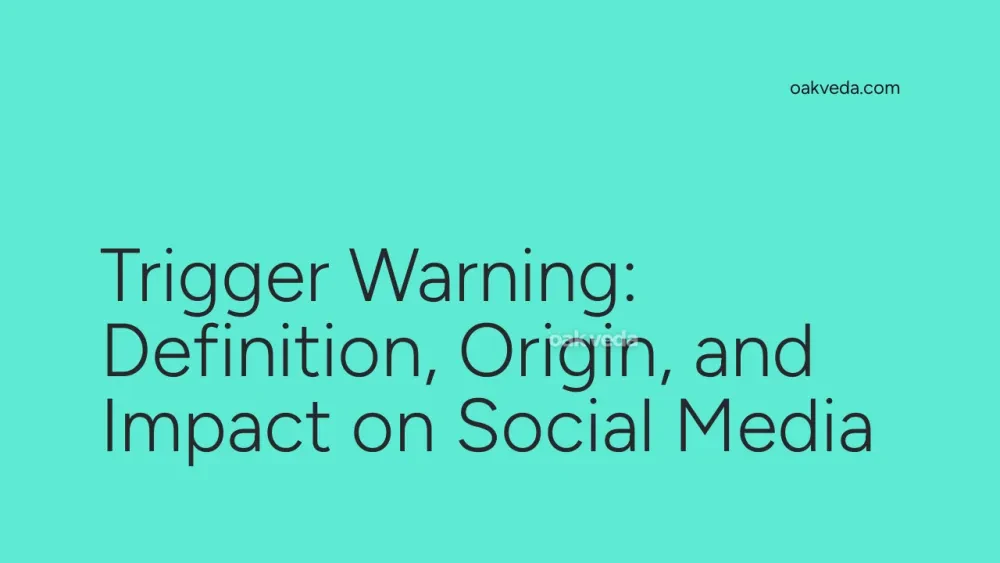
What is a Trigger Warning?
A trigger warning (TW) is a cautionary statement placed before potentially distressing content on social media platforms, blogs, or other online spaces. It serves as a heads-up for users who might be sensitive to specific topics due to past trauma or personal experiences. Trigger warnings allow individuals to make informed decisions about engaging with content that could negatively impact their mental health or emotional well-being.
Origin and Development of Trigger Warnings
The concept of trigger warnings originated in the late 1990s within feminist circles and online forums. Initially used to alert readers about content related to sexual assault, the practice gradually expanded to cover a broader range of potentially triggering topics. As social media platforms gained popularity in the 2000s and 2010s, trigger warnings became more widespread, evolving into a common practice across various online communities.
How Trigger Warnings Work
Trigger warnings typically appear at the beginning of a post, video, or article. They often use the abbreviation "TW" followed by a brief description of the potentially triggering content. For example:
- TW: Sexual assault
- TW: Graphic violence
- TW: Eating disorders
Users can then decide whether to proceed with viewing the content or to skip it if they feel it might be too distressing.
Types of Trigger Warnings
While there's no standardized format for trigger warnings, they generally fall into several categories:
- Content-specific warnings: These describe the nature of the potentially triggering material (e.g., TW: Self-harm).
- Intensity-based warnings: Some creators use a rating system to indicate the severity of the content (e.g., TW: Mild discussion of anxiety).
- Spoiler-style warnings: On platforms like Tumblr, users may hide potentially triggering content behind a "read more" link or spoiler tag.
- Visual cues: Some social media platforms have introduced features that blur potentially sensitive images until users choose to view them.
Popular Examples of Trigger Warnings on Social Media
Trigger warnings have become commonplace across various social media platforms:
- Twitter: Users often include TWs in their tweets or thread introductions.
- Instagram: Content creators may add TWs in their captions or as text overlays on images.
- TikTok: Videos discussing sensitive topics often start with a verbal or written trigger warning.
- Facebook: Groups and pages dedicated to mental health support frequently use TWs for posts and discussions.
Impact of Trigger Warnings on Social Media Culture
The widespread adoption of trigger warnings has significantly influenced online communication and content consumption:
- Increased awareness: TWs have raised awareness about mental health and the diverse experiences of social media users.
- Community building: The use of TWs has fostered more supportive and empathetic online communities.
- Content moderation: Some platforms have incorporated TW-related features into their content moderation policies.
- Changed user behavior: Many users now actively look for or expect TWs before engaging with certain types of content.
Controversies and Debates Surrounding Trigger Warnings
Despite their widespread use, trigger warnings remain a topic of debate:
- Effectiveness: Some studies question whether TWs actually reduce distress or if they might increase anxiety in some cases.
- Overuse: Critics argue that excessive use of TWs can lead to oversensitivity and avoidance of important discussions.
- Academic freedom: The implementation of TWs in educational settings has sparked debates about censorship and academic freedom.
- Standardization: There's ongoing discussion about whether TWs should be standardized across platforms for consistency.
How Brands and Influencers Use Trigger Warnings
Many brands and influencers have incorporated trigger warnings into their social media strategies:
- Responsible marketing: Brands use TWs when discussing sensitive topics in their campaigns or social responsibility initiatives.
- Influencer transparency: Many influencers use TWs to maintain trust with their audience when sharing personal stories or discussing challenging topics.
- Mental health advocacy: Some brands and influencers actively promote the use of TWs as part of broader mental health awareness campaigns.
Future Trends Related to Trigger Warnings
As social media continues to evolve, so too will the use of trigger warnings:
- AI-powered content warnings: Platforms may develop AI algorithms to automatically detect and label potentially triggering content.
- Personalized warning systems: Users might be able to customize their TW preferences based on individual sensitivities.
- Integration with content recommendation algorithms: TWs could influence how content is recommended to users, creating safer browsing experiences.
- Expanded use in virtual and augmented reality: As these technologies grow, TWs may be adapted for immersive experiences.
FAQs about Trigger Warnings
-
Are trigger warnings legally required? No, there's no legal requirement for using trigger warnings on social media. Their use is voluntary and based on community norms.
-
Do trigger warnings censor content? Trigger warnings don't censor content; they provide information to help users make informed choices about what they view.
-
Can trigger warnings be harmful? While intended to help, some argue that TWs might increase anxiety or avoidance behaviors in certain individuals. Research on their effectiveness is ongoing.
-
How do I know when to use a trigger warning? Consider using a TW when posting content that deals with trauma, violence, or other potentially distressing topics. When in doubt, it's often better to include a warning.
-
Do all social media platforms support trigger warnings? While most platforms allow users to include TWs in their posts, not all have specific features dedicated to content warnings. Users often adapt their use of TWs to fit each platform's format.
By understanding and appropriately using trigger warnings, social media users can contribute to creating more inclusive and supportive online communities while respecting the diverse experiences and sensitivities of others.
You may be interested in:
- Micro-Influencers: Definition, Origin, and Impact
- Unserious: Definition, Origin, and Impact on Social Media
- Krissed: Definition, Origin, and Impact on Social Media
- Brand Style Guide: Definition, Origin, and Impact
- Mega-Influencer: Definition, Origin, and Impact on Social Media
- Era: Definition, Origin, and Impact on Social Media Culture

